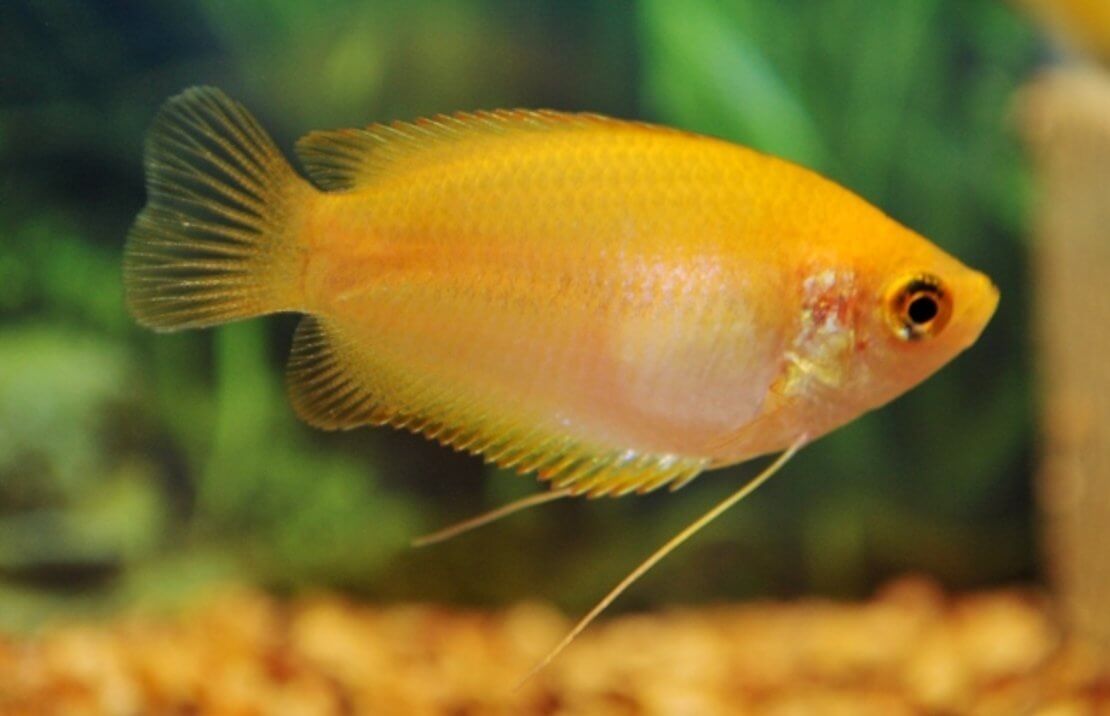The fish with the ventral fins pulled out too long are called gouramis or gouramis. They belong to the labyrinth fish that have to breathe air on the surface. Its smallest representative is the honey gourami.
uiga

- Name: honey gourami, trichogaster chuna
- Faiga: Labyrinth fish
- Tele: 4-4.5 cm
- Origin: Northeast India, Bangladesh
- Uiga: faigofie
- Tele o le vai vai: mai le 54 lita (60 cm)
- pH tau: 6-7.5
- Vai vevela: 24-28 ° C
Interesting Facts About the Honey Gourami
Igoa faasaienisi
Trichogaster chuna
isi igoa
Colisa chuna, Colisa sota, Polyacanthus chuna, Trichopodus chuna, Trichopodus sota, Trichopodus soto, honey threadfish
Systematics
- Vasega: Actinopterygii (au apa)
- Poloaiga: Perciformes (pei-pei)
- Aiga: Osphronemidae (Guramis)
- Genus: Trichogaster
- Type: Trichogaster chuna (honey gourami)
fua
The males reach a length of about 4 cm, rarely 4.5 cm. The females can get a little larger, up to a maximum of 5 cm.
lanu
The males are colored flat black from the head over the abdomen to shortly before the end of the anal fin. The sides of the body, the rest of the anal fin, the other fins except for the upper part of the dorsal fin are orange-red, the latter is yellow. If you feel unwell or in the dealer pool, these colors can only be weak. The females are more beige with a slightly greenish tinge, but a broad brown longitudinal stripe from the eye to the caudal fin. There are three cultivated forms. In the case of the golden one, the males are almost continuously yellow, only the rear dorsal, anal and caudal fins are reddish. The females are also yellow but show the brown longitudinal ligament. In the cultivated form “Fire” the fins are colored like in “Gold”, but the body is more beige, in “Fire Red” the whole fish is colored bright red.
māfuaʻaga
The honey gourami originally comes from the tributaries of the Ganges and Brahmaputra in northeastern India and Pakistan. Despite its small size, it is used as food fish there.
Eseesega o alii ma tamaitai
The clearest difference, which can also be seen in fish that has not been colored, is the longitudinal stripe of the female, which can also be seen by males who are under stress. The yellow upper edge of the dorsal fin is at least partially visible in them. Adult females are fuller.
Toe gaosia
The honey gourami builds a rather sloppy, not very dense foam nest from saliva-filled air bubbles, which consists of only one layer of bubbles. When the male thinks it is ready, the female is lured under the nest by presenting the black belly and the splendid coloring. After spawning, the male spits the eggs together into a spawning lump. After one to two days – this depends on the temperature – the larvae hatch, after another two to three days they swim freely. Then the brood-care instinct of the male ceases, which up to this point has defended the nest and its surroundings against intruders.
Soifuaga o le olaga
The honey gourami is around two to two and a half years old. A position that is not too warm (24-26 ° C) extends life expectancy somewhat.
Faʻamatalaga Matagofie
taumafa
Honey gouramis are omnivores. The basis is dry food (flakes, small granules), which should be supplemented with small live or frozen food two to three times a week. Many labyrinth fish do not tolerate red mosquito larvae and under certain circumstances, they can develop a fatal intestinal inflammation, so you should avoid them.
Fua lapoʻa
In smaller aquariums, they should be kept in pairs. The larger the aquarium, the more pairs can be kept in it (80 cm: 2 pairs; 100 cm: 4 pairs).
Tele o le vai
Although the males are territorial during the nest-building period and scare the females out of this area, the aquarium only needs to have an edge length of 60 cm (54 L volume) for a couple if there is a good structure and sufficient retreats.
Mea faigaluega vaitaele
Part of the aquarium should be densely planted so that females who are too pressured can retreat here. For example also during the brood care period of the male, when it is a little more aggressive than usual. Additional floating plants give the animals security. Part of the water surface should remain free and is used to build the foam nest there. Since the water values do not play a major role, roots can also be used. A dark substrate allows the colors of the males to stand out better.
Social dwarf gourami
Since honey gouramis are not particularly aggressive, they can be socialized with much other peaceful fish of about the same size or slightly smaller. How many of them can fit depends on the size of the aquarium. Under no circumstances may barbel or other fish that have to be plucked be kept together with honey gouramis, which, like the Sumatra bar, nibble on the pelvic fin threads.
Fa'atauga vai mana'omia

The temperature should be between 24 and 26 ° C and the pH value should be 6-7.5. Higher temperatures are well tolerated for a period that is not too long and then encourages breeding and foam nest building.
